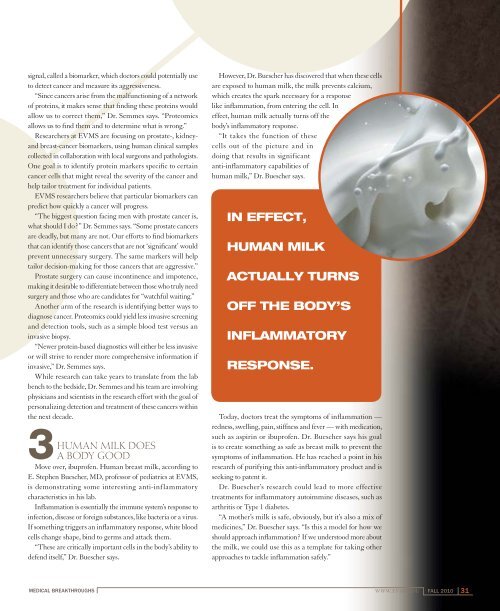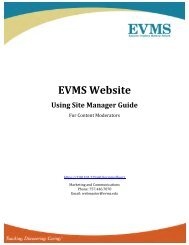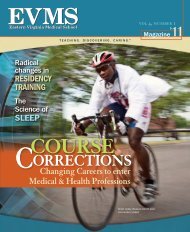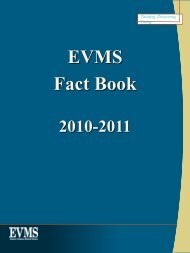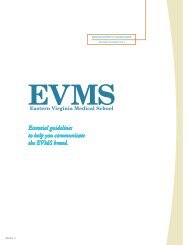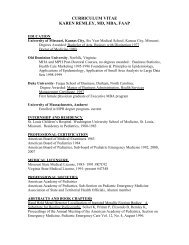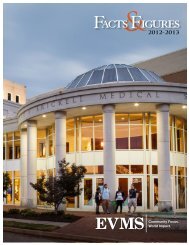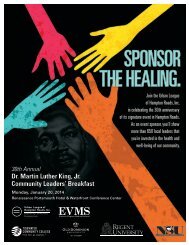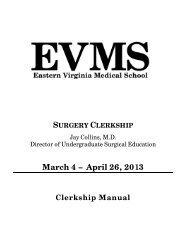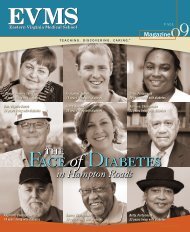Fall 2010 - Eastern Virginia Medical School
Fall 2010 - Eastern Virginia Medical School
Fall 2010 - Eastern Virginia Medical School
Create successful ePaper yourself
Turn your PDF publications into a flip-book with our unique Google optimized e-Paper software.
signal, called a biomarker, which doctors could potentially useto detect cancer and measure its aggressiveness.“Since cancers arise from the malfunctioning of a networkof proteins, it makes sense that finding these proteins wouldallow us to correct them,” Dr. Semmes says. “Proteomicsallows us to find them and to determine what is wrong.”Researchers at EVMS are focusing on prostate-, kidneyandbreast-cancer biomarkers, using human clinical samplescollected in collaboration with local surgeons and pathologists.One goal is to identify protein markers specific to certaincancer cells that might reveal the severity of the cancer andhelp tailor treatment for individual patients.EVMS researchers believe that particular biomarkers canpredict how quickly a cancer will progress.“The biggest question facing men with prostate cancer is,what should I do?” Dr. Semmes says. “Some prostate cancersare deadly, but many are not. Our efforts to find biomarkersthat can identify those cancers that are not ‘significant’ wouldprevent unnecessary surgery. The same markers will helptailor decision-making for those cancers that are aggressive.”Prostate surgery can cause incontinence and impotence,making it desirable to differentiate between those who truly needsurgery and those who are candidates for “watchful waiting.”Another arm of the research is identifying better ways todiagnose cancer. Proteomics could yield less invasive screeningand detection tools, such as a simple blood test versus aninvasive biopsy.“Newer protein-based diagnostics will either be less invasiveor will strive to render more comprehensive information ifinvasive,” Dr. Semmes says.While research can take years to translate from the labbench to the bedside, Dr. Semmes and his team are involvingphysicians and scientists in the research effort with the goal ofpersonalizing detection and treatment of these cancers withinthe next decade.3HUMAN MILK DOESA BODY GOODMove over, ibuprofen. Human breast milk, according toE. Stephen Buescher, MD, professor of pediatrics at EVMS,is demonstrating some interesting anti-inflammatorycharacteristics in his lab.Inflammation is essentially the immune system’s response toinfection, disease or foreign substances, like bacteria or a virus.If something triggers an inflammatory response, white bloodcells change shape, bind to germs and attack them.“These are critically important cells in the body’s ability todefend itself,” Dr. Buescher says.However, Dr. Buescher has discovered that when these cellsare exposed to human milk, the milk prevents calcium,which creates the spark necessary for a responselike inflammation, from entering the cell. Ineffect, human milk actually turns off thebody’s inflammatory response.“It takes the function of thesecells out of the picture and indoing that results in significantanti-inflammatory capabilities ofhuman milk,” Dr. Buescher says.In effect,human milkactually turnsoff the body’sinflammatoryresponse.Today, doctors treat the symptoms of inflammation —redness, swelling, pain, stiffness and fever — with medication,such as aspirin or ibuprofen. Dr. Buescher says his goalis to create something as safe as breast milk to prevent thesymptoms of inflammation. He has reached a point in hisresearch of purifying this anti-inflammatory product and isseeking to patent it.Dr. Buescher’s research could lead to more effectivetreatments for inflammatory autoimmine diseases, such asarthritis or Type 1 diabetes.“A mother’s milk is safe, obviously, but it’s also a mix ofmedicines,” Dr. Buescher says. “Is this a model for how weshould approach inflammation? If we understood more aboutthe milk, we could use this as a template for taking otherapproaches to tackle inflammation safely.”MEDICAL BREAKTHROUGHSwww.evms.edu FALL <strong>2010</strong> 31


